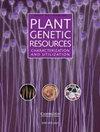Introgression of the coupled Fhb1-Sr2 to increase Fusarium head blight and stem rust resistance of elite wheat cultivars
IF 0.7
4区 生物学
Q3 PLANT SCIENCES
Plant Genetic Resources: Characterization and Utilization
Pub Date : 2022-05-24
DOI:10.1017/s1479262122000107
引用次数: 1
Abstract
Fusarium head blight (FHB) and stem rust (SR) threaten the sustainability of wheat production worldwide. Fhb1 and Sr2 confer partial durable resistance to FHB and SR, respectively. Despite resistant alleles of both genes are linked in repulsion, lines with Fhb1-Sr2 in coupling were developed at the University of Minnesota, USA. Marker-assisted backcrossing was used to incorporate the coupled Fhb1-Sr2 into four elite INIA-Uruguay spring wheat varieties lacking both genes and expressing different levels of FHB and SR resistance. In each case, the initial cross between the donor line and recurrent parent was backcrossed three times. Genotypes carrying Fhb1-Sr2 were selected using the molecular marker UMN10. In BC3F3 families, retention of Fhb1-Sr2 was further confirmed with the markers SNP3BS-8 and Sr2-ger9 for Fhb1 and Sr2, respectively. BC3F3 homozygous lines contrasting at UMN10, SNP3BS-8 and Sr2-ger9 were obtained to quantify the effect of Fhb1-Sr2 on the resistance to FHB under controlled conditions and to SR under field conditions. After 26 months period, successful introgression of Fhb1-Sr2 into the four cultivars was achieved, representing novel wheat genetic resources. Lines homozygous for the resistant alleles of Fhb1 were significantly more resistant to FHB as reflected by an 18% reduction of average FHB area under the disease progress curve. A significant effect of Sr2 on SR field resistance was observed in lines derived from the most susceptible cultivar ‘Génesis 2375’. The most resistant lines to both diseases are expected to be valuable genetic resources in breeding for durable resistance to FHB and SR.Fhb1-Sr2偶联基因渗入提高小麦优良品种抗枯萎病和茎锈病能力
小麦赤霉病(Fusarium head blight, FHB)和茎锈病(stem rust, SR)威胁着全球小麦生产的可持续性。Fhb1和Sr2分别赋予对FHB和SR的部分持久抗性。尽管这两个基因的抗性等位基因在排斥中联系在一起,但美国明尼苏达大学开发了Fhb1-Sr2偶联的系。利用标记辅助回交技术,将Fhb1-Sr2偶联基因整合到4个缺乏Fhb1-Sr2基因且表达不同水平FHB和SR抗性的inia -乌拉圭春小麦优良品种中。在每种情况下,供体系和复发亲本之间的初始杂交都进行了三次回交。利用分子标记UMN10选择携带Fhb1-Sr2的基因型。在BC3F3家族中,Fhb1-Sr2的保留进一步被标记物SNP3BS-8和Sr2-ger9分别证实。获得UMN10、SNP3BS-8和Sr2-ger9的BC3F3纯合子,定量Fhb1-Sr2在对照条件下和田间条件下对赤霉病抗性的影响。经过26个月的时间,Fhb1-Sr2基因成功导入4个品种,代表了小麦的新遗传资源。Fhb1抗性等位基因的纯合子系对FHB的抗性显著增强,这反映在疾病进展曲线下平均FHB面积减少18%。在Sr2对SR田间抗性有显著影响的品种“gsamnesis 2375”中观察到。对这两种疾病的抗性最强的品系有望成为对赤霉病和SR的持久抗性育种的宝贵遗传资源。
本文章由计算机程序翻译,如有差异,请以英文原文为准。
求助全文
约1分钟内获得全文
求助全文
来源期刊

Plant Genetic Resources: Characterization and Utilization
Agricultural and Biological Sciences-Agronomy and Crop Science
CiteScore
2.80
自引率
0.00%
发文量
29
审稿时长
>12 weeks
期刊介绍:
Plant Genetic Resources is an international journal which provides a forum for describing the application of novel genomic technologies, as well as their integration with established techniques, towards the understanding of the genetic variation captured in both in situ and ex situ collections of crop and non-crop plants; and for the airing of wider issues relevant to plant germplasm conservation and utilisation. We particularly welcome multi-disciplinary approaches that incorporate both a technical and a socio-economic focus. Technical aspects can cover developments in technologies of potential or demonstrated relevance to the analysis of variation and diversity at the phenotypic and genotypic levels.
 求助内容:
求助内容: 应助结果提醒方式:
应助结果提醒方式:


